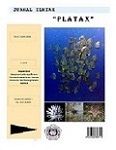Community Structure Of Sea Cucumber (Holothuroidea) In The Coastal Area Of The Island Of Jailolo Subdistrict Nyaregilaguramangofa South Halmahera Regency West Of North Maluku
DOI:
https://doi.org/10.35800/jip.5.2.2017.15910Abstract
Sea cucumbers (Holothuroidea) are a group of marine invertebrate animals of the class Holothuroidea (phylum Echinodermata). At present, hunting of sea cucumbers is not only targeted at species of high economic value, but also of low economic value. The pressure of exploitation has led to a decline in the population that can cause changes in the structure of the community. The purpose of this research is to understand the type of sea cucumber, analyze the structure of sea cucumber which includes individual density, diversity index, domination index, inter species association and dispersion pattern. Sampling was conducted at night during the lowest tide in April 2016. Based on the results of research conducted in the coastal area of Nyaregilaguramangofa Island, South Jailolo district, West Halmahera Regency, North Maluku. Species of sea cucumbers found in the study sites were 6 species of sea cucumber: Holothuria atra, Holothuria hilla, Holothuria scabra, Bohadschia marmorata, Bohadschia vitiensis and Ophedesoma grisea, each with an average individual density of 0.029 ind/m2, the diversity index (H '= 1,495), the fairness index (e = 0.834), the dominance index (C = 0.260), the association between the six species forming 4 pairs of positive associations and 11 pairs of negative associations and the entire population has a randomly distributed pattern.
Keywords: Structure communities, Holothuroidea, Nyaregilaguramangofa, Nort Maluku Â
ABSTRAKTeripang (Holothuroidea) adalah kelompok hewan avertebrata laut dari kelas Holothuroidea (filum Echinodermata). Pada saat ini, perburuan teripang tidak hanya ditargetkan pada spesies yang bernilai ekonomis tinggi, tetapi juga yang bernilai ekonomis rendah. Tekanan eksploitasi telah menyebabkan penurunan populasi yang dapat menyebabkan perubahan pada struktur komunitasnya. Adapun tujuan dari penelitian ini yaitu untuk memahami jenis teripang, menganalisis struktur teripang yang meliputi kepadatan individu, indeks keanekaragaman, indeks dominasi, asosiasi antar spesies dan pola penyebaran. Pengambilan sampel dilakukan pada malam hari saat surut terendah pada bulan April 2016. Berdasarkan hasil penelitian dilakukan di kawasan pantai Pulau Nyaregilaguramangofa, kec. Jailolo Selatan Kab. Halmahera Barat, Maluku Utara. Spesies teripang yang ditemukan di lokasi penelitian berjumlah 6 spesies teripang: Holothuria atra, Holothuria hilla, Holothuria scabra, Bohadschia marmorata, Bohadschia vitiensis dan Ophedesoma grisea, masing-masing dengan kepadatan individu rata-rata 0.029 ind/m, indeks keanekaragaman (H' = 1.495), indeks kemerataan atau keserasian (e = 0.834), indeks dominansi (C = 0.260), asosiasi antar 6 spesies membentuk 4 pasang asosiasi positif dan 11 pasang asosiasi negatif dan keseluruhan populasi memiliki pola penyebaran secara  acak.
Kata kunci : Struktur komunitas, teripang, Nyaregilaguramangofa, Maluku UtaraÂ
Downloads
Published
How to Cite
Issue
Section
License
COPYRIGHT
Authors who publish with this journal agree to the following terms:
Authors hold their copyright and grant this journal the privilege of first publication, with the work simultaneously licensed under a Creative Commons Attribution License that permits others to impart the work with an acknowledgment of the work's origin and initial publication by this journal.
Authors can enter into separate or additional contractual arrangements for the non-exclusive distribution of the journal's published version of the work (for example, post it to an institutional repository or publish it in a book), with an acknowledgment of its underlying publication in this journal.
Authors are permitted and encouraged to post their work online (for example, in institutional repositories or on their website) as it can lead to productive exchanges, as well as earlier and greater citation of the published work (See The Effect of Open Access).






































